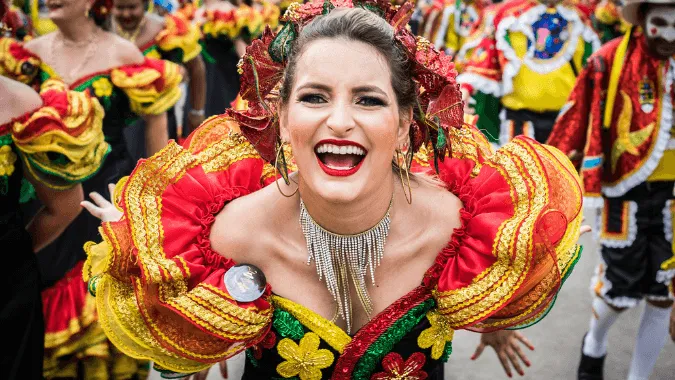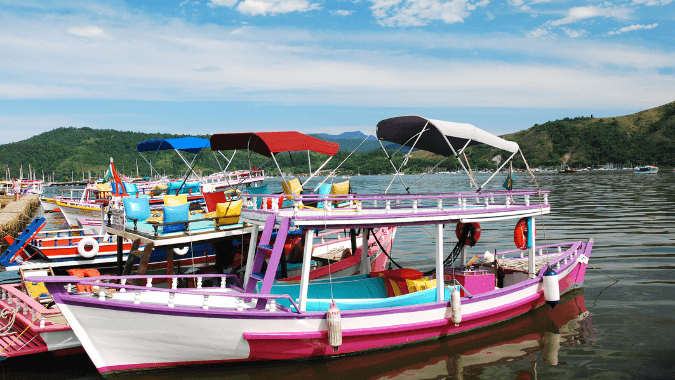All about Rio de Janeiro: attractions, tips, when is the best time to go
What attracts tourists to Rio de Janeiro?
Rio de Janeiro can be considered one of the most beautiful cities in the world. And no wonder, because the city is surrounded by the ocean and lush tropical forests, and the number of attractions is simply amazing.
Just look at the huge Botanical Garden, which has existed since the nineteenth century. Its 138 hectares are home to more than 6,000 different species of tropical and subtropical plants and trees. This is a great place for relaxing walks. The Tijuca Forest Park, located in the city center, also deserves special attention. Here you can walk along the paths of the forest park, visit caves, see tropical animals and beautiful waterfalls, and having climbed to the top of Tijuca, you can enjoy the landscape of the entire city.
In the Rio suburb of Niteroi, founded in the sixteenth century, there is a museum of modern art. There is a truly quiet and peaceful atmosphere here. A meal in a churrascaria will leave no one indifferent. This is a kind of traditional grill restaurant. In such an establishment you can taste all kinds of variations of meat dishes, salads, pastries, local cuisine and cheeses and other delicacies.
The thirty-eight-meter statue of Christ the Redeemer, located on Mount Corvocado, is the calling card of Rio de Janeiro and Brazil as a whole. The observation deck at the foot of the statue offers a beautiful view of Rio. You can also see the city from the top of Sugar Mountain. You can get here by special cable car lifts. There are three stops along the way. From the top you can see such famous places in the city as the Tijuca Forest Park, Copacabana and Ipanema beaches, the statue of Jesus Christ and part of Niteroi.
When you first arrive in Rio de Janeiro, we recommend using Rio De Janeiro airport transfers to get to your hotel as quickly as possible without problems and annoying taxi drivers with inflated prices. You can also use this service from Kiwitaxi on the way back to the airport, ordering the same transfer service.
Lovers of extreme sensations should book a tour of the favelas - the poorest neighborhoods of Rio de Janeiro, where poverty and crime flourish, since these areas are almost not controlled by the city authorities. This is the downside of the colorful and fun life in Rio.
Not seeing the Samba Carnival in Rio is unacceptable. The carnival itself lasts for 4 days before Lent, until Ash Wednesday arrives. Even if you can’t get to the carnival itself, you can attend its rehearsals. They last for several months at the Sambodrome. Anyone can come here and watch the preparation of different samba schools for the next carnival.
The pride of sports architecture can be called the second largest operating Maracanã stadium in the world. Since the residents of the city are different lovers of football and fun life, the matches here are all accompanied by songs, dances, drumming and drinking alcoholic beverages. The spectacle is quite noisy and fun.
The beaches in Rio de Janeiro can also be classified as the city's attractions. Copacabana and Ipanema are considered the most crowded and popular. But besides them, you can also highlight quieter and more comfortable beaches such as Arpoador and Sau Cornado, where you can relax and soak up more sea and sun.
Top 10 attractions
1. Mount Corcovado with Christ
The symbol of Brazil and the new Wonder of the World. You can climb it by cable car or minibus. And admire the views of the city! Be prepared for huge crowds of visitors.
2. Sugarloaf Mountain (Pão de Azucar)
You can see the city from a different angle here. To get to Sugarloaf, you must first climb Mount Urka (on foot or by cable car), and then only in the cable car cabin. There are fewer people here than in Corcovado, a more relaxed and pleasant atmosphere. It makes sense to come at sunset.
3. Copacabana beach
Brazil's most famous beach with soft white sand - if you want to relax and swim in the warm waters of the Atlantic, then this attraction should be on your list.
4. Museum of Tomorrow (Museu do Amanhã)
Built for the Olympic Games in Rio, the museum is primarily striking for its architecture, it is solar-powered, and the exhibitions inside are dedicated to the environmental and social problems of the planet.
5. Botanical Garden (Jardim Botânico)
A great place to take a break from the noisy city. The garden is huge, but there are few flowers there, but there is a huge variety of green plants and exotic trees.
6. Graffiti (Olympic Boulevard)
This attraction was also created for the Olympic Games. The largest graffiti in the world depicts representatives of different parts of the Light instead of the Olympic rings.
7. Staircase made of tiles (Escadaria Selarón)
The staircase was created by the Brazilian artist Selaron, they say he was a little crazy. I started decorating my porch with tiles and went all the way up the stairs. And there are all sorts of tiles here - from all over the world: including Alaska, India, Portugal, etc.
8. Catedral Metropolitana de São Sebastião
The controversial building, reminiscent of a factory chimney from the outside, delights with the play of light and stained glass windows inside. The architect intended to combine the concept of a Mayan pyramid and a Catholic temple. How he did it is up to you to decide. By the way, you can book a transfer and to see this famous place. For more info, you should visit their official website.
9. Bibliothek Real Escritório Portugues Da Leitura
It's easy to take amazing Harry Potter-themed photos at the historic library in the city center. Open only on weekdays.
10. Vintage Santa Teresa Tram
The historic tram line connects the city center with the first residential area of Santa Teresa. This is all that remains of Rio's once extensive tram system.
And of course, the main attraction is the Brazilian carnival!
How to plan a trip
When to go
Overall, Brazil is a year-round holiday destination. In the southern hemisphere, the opposite is true: in the south it is colder than in the north, summer occurs from December to March, and winter from June to August. Brazil has the most predictable climate in the central part of the country: Rio de Janeiro, Vitoria, Belo Horizonte.
If you want to go to the famous Brazilian carnival, plan your trip in February. This way you can kill two birds with one stone: enjoy the local summer season and attend a traditional festival.
How to get around
Passenger railways are poorly developed in Brazil, so there are three different ways to travel within the country: by plane, by bus or by rented car.
Getting somewhere far away by car can be a little challenging due to the long distances, but this is more than compensated for by the variety of domestic flights.
How to find a common language
The official language of Brazil is Portuguese. Tourists who are used to speaking English everywhere will have a hard time, so it’s better to learn a few phrases in Portuguese and download an offline translator.
Safety
Brazil is strongly associated with crime. Is it really that bad? The answer depends not only on the city, but also on the area where you stay.
Let's take for example one of the country's main tourist destinations - Rio de Janeiro. It gained notoriety in part because of the 2002 crime drama City of God about drug wars, life in local slums and social inequality. However, if you open a map of the city, you will see how huge it is, and all the scary stories are mainly associated with the so-called Zona Norte (northern part), in which a random tourist is unlikely to find himself even with a strong desire. But Zona Sul, south of Rio, is the complete opposite of the north: there is excellent infrastructure, lots of entertainment for tourists, beaches and a completely different standard of living.
Copacabana, Ipanema, Leblon, Barra da Tijuca - choosing any of these areas, you can relax. But still remember the safety rules: check the map of the area so as not to end up in a bad neighborhood, leave expensive jewelry at home, withdraw money only from ATMs at banks, and avoid walking at night.
What to try in Rio de Janeiro
Brazilians love food. Let’s not be left behind and, as a snack, we’ll make a list of dishes that are definitely worth trying in Brazil.
The undisputed leader in the rating will be Shurasku - Brazilian barbecue. Another hallmark of Brazilian cuisine is feijoada, beans cooked with meat, one of the main everyday dishes in Brazil. For dessert, order a traditional Brazilian dessert - brigadeiro, which will long preserve the sweet memories of your trip.
In general, to try a little bit of everything, go to rodizio - the Brazilian equivalent of a buffet. These are restaurants where they charge only for entrance, and all dishes are already included in the price.
What to bring from your trip
Probably the simplest, but no less valuable souvenir from Brazil is local coffee. For those who do not drink it, there is an alternative option in the form of tonic mate tea.
Football souvenirs - a ball or a T-shirt of the Brazilian national team - can become a valuable gift for fans of this sport.
From the northern regions of the country you can bring Indian costumes, and from the southern regions you can bring shimarron tea, a Brazilian version of finely ground mate tea.
By: John Carter
-
Exciting 4x4 route: São Luís and FortalezafromUS$1,014
-
Vila Gale Mares Resort All InclusivefromUS$100
-
Ecotourism in Chapada DiamantinafromUS$672
-
All inclusive Vila Gelé Cumbuco ResortfromUS$999
-
Full Day Cafayate Tour from SaltafromUS$68
-
Transfer Aeroparque - Buenos AiresfromUS$46
-
-
Transfer Ezeiza - AeroparquefromUS$91
-
-
Excursion to El Chaltén from El CalafatefromUS$153
-
-
-
-
-
-
-
-
-
-
-
















